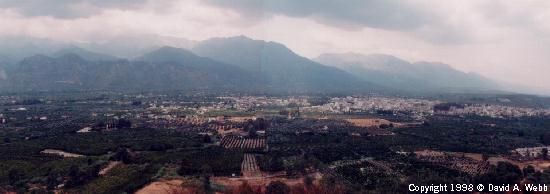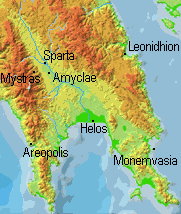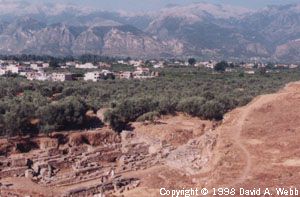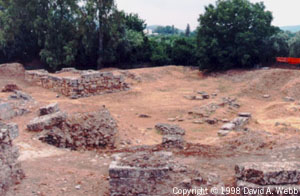


Before the new national road that links Mycenae and Tripoli, and thence Sparta, was finished (a safe but comparatively dull ride), the best route from most spots in the Argive plain was through the Kleisoura Pass. The spectacular views may still make it worth your while if you are riding with someone else (drivers unfortunately do not get a chance to enjoy the views!). If you are on a bus, you will probably venture back up near Nemea and come down the new highway, which does offer relatively unspoiled countryside views.
The modern town of Sparta is a little south of the ancient
one, of which there is very little remaining. It sits in the plain
of the River Eurotas between the towering peaks of Mount Taygetos and the
ravine etched hills of the Menelaion. It was described by Strabo
(8.5.1)
in the late 1st century B.C.E. as "a rather hollow  district,"
but it is the comment by Thucydides (1.10.2)
that is most often remembered:
district,"
but it is the comment by Thucydides (1.10.2)
that is most often remembered:
For I suppose if Lacedaemon were to become desolate, and the temples and the foundations of the public buildings were left, that as time went on there would be a strong disposition with posterity to refuse to accept her fame as a true exponent of her power. And yet they occupy two-fifths of Peloponnese and lead the whole, not to speak of their numerous allies without. Still, as the city is neither built in a compact form nor adorned with magnificent temples and public edifices, but composed of villages after the old fashion of Hellas, there would be an impression of inadequacy. Whereas, if Athens were to suffer the same misfortune, I suppose that any inference from the appearance presented to the eye would make her power to have been twice as great as it is.
The Ancient Sites
If you have just arrived in town, I suggest visiting
the archaeological museum before you walk to the remains of the acropolis.
As Thucydides mentioned, there is not an overwhelming amount of architectural
remains on the site, but some of the finest pieces are now on display at
the museum, and you will probably have a better idea of the local Spartan
uniqueness if you spend an hour or so at the museum first. It made
my visit to the actual site more enjoyable and more imaginative (if you
will permit me to wax romantic here!).
On my first visit I did not have time to stop by the archaeological museum of Sparta, but it is home to a number of very important archaeological finds. Possibly the most spectacular of these are the choicest of the tens of thousands of bronze archaic figurines dedicated to the goddess Artemis Orthia. There are a number of other votive objects and a few surprising terra-cotta masks. There is a well known bust of Leonidas in marble and a number of stelae. If you enjoy bronze age pottery there is a collection of Mycenaean finds from multiple sites across Laconia and even some attractive mosaics.
 The
main archaeological site in town is the Acropolis
of Sparta (on the bus in, after passing over the Eurotas River, you
will veer to the left and then back to the right, thereby avoiding the
edge of the Acropolis). You can walk there from the middle of town
by going towards the football stadium on the north of town (just a few
blocks north of the central plaza) and then going around it, up a beautiful
tree lined road. Walls once surrounded the acropolis (the highest
of a series of low hills north of the town), but only after the Spartans
had lost their hold on the Peloponnese. During the Peloponnesian
War they had nothing to fear from the Athenians on land. There are
many olive trees covering the acropolis, but you can still get a good view
of the Roman
theater (first century B.C.E.). It was actually the second largest
theater in all of Greece (after Megalopolis), but it is not in a good condition
today. Most of the marble has been robbed out. If you do visit,
note the drawings of the ancient stage in the Blue Guide (one theory on
the design of the stage), the skene would be decorated and rolled
on metal rods out of a shed adjacent to the theater. Other foundations
and remnants of Classical, Roman, and Byzantine buildings remain on the
acropolis, but you will need a site plan to point out exactly what is what.
Look up some of the books provided in the bibliography below or some of
the archaeological excavation reports and make a photocopy of the site
plan. You will appreciate it much more when you are standing on the acropolis,
wondering what this building and that foundation were!
The
main archaeological site in town is the Acropolis
of Sparta (on the bus in, after passing over the Eurotas River, you
will veer to the left and then back to the right, thereby avoiding the
edge of the Acropolis). You can walk there from the middle of town
by going towards the football stadium on the north of town (just a few
blocks north of the central plaza) and then going around it, up a beautiful
tree lined road. Walls once surrounded the acropolis (the highest
of a series of low hills north of the town), but only after the Spartans
had lost their hold on the Peloponnese. During the Peloponnesian
War they had nothing to fear from the Athenians on land. There are
many olive trees covering the acropolis, but you can still get a good view
of the Roman
theater (first century B.C.E.). It was actually the second largest
theater in all of Greece (after Megalopolis), but it is not in a good condition
today. Most of the marble has been robbed out. If you do visit,
note the drawings of the ancient stage in the Blue Guide (one theory on
the design of the stage), the skene would be decorated and rolled
on metal rods out of a shed adjacent to the theater. Other foundations
and remnants of Classical, Roman, and Byzantine buildings remain on the
acropolis, but you will need a site plan to point out exactly what is what.
Look up some of the books provided in the bibliography below or some of
the archaeological excavation reports and make a photocopy of the site
plan. You will appreciate it much more when you are standing on the acropolis,
wondering what this building and that foundation were!
If you are interested in a longer description of the site,
Pausanias gave a good description (3.11.1).
The other major archaeological site in Sparta is the Sanctuary
of Artemis Orthia, a famous sanctuary that has been preserved by the
silt of the Eurotas River. It sits a little further away from the
center of town, but definitely within walking distance. If you just
follow the main road that brought you in to town, Odos Tripoleos, you will
see the signs pointing you down a small road to the right (as you are leaving
town). It is only about one kilometer from the town's central plateia.
The sanctuary itself is visible through the chain link fence that surrounds
it, but I think during the morning and early afternoons the gate is opened
and you can go inside. Most of what is visible today are the remains
of the Roman theater that was built at the site during the second century
C.E. But the remnants of the Temple of Artemis Orthia are still visible
(though it also had several different stages).  The
sanctuary was formed at some point before the 10th century B.C.E. and a
long altar was the site of sacrifices to the goddess, probably of young
men hoping for victory or celebrating victory in contests for the goddess.
This developed at some point into a brutal contest young Spartan boys participated
in. The winner of the contest was the one who could endure flogging
the longest. Needless to say many boys died as a result of the contests
and the ones that won were highly honored. The Romans later, enamored
by the resemblance of Spartan customs to their own militaristic and, for
lack of a better word, "Spartan" mores, constructed a theater around the
central area in front of the temple (with the temple and its altar serving
as a stage for the very real show). Twisted? Maybe. But then
again, Ice Hockey is popular today, is it not?
The
sanctuary was formed at some point before the 10th century B.C.E. and a
long altar was the site of sacrifices to the goddess, probably of young
men hoping for victory or celebrating victory in contests for the goddess.
This developed at some point into a brutal contest young Spartan boys participated
in. The winner of the contest was the one who could endure flogging
the longest. Needless to say many boys died as a result of the contests
and the ones that won were highly honored. The Romans later, enamored
by the resemblance of Spartan customs to their own militaristic and, for
lack of a better word, "Spartan" mores, constructed a theater around the
central area in front of the temple (with the temple and its altar serving
as a stage for the very real show). Twisted? Maybe. But then
again, Ice Hockey is popular today, is it not?
During my second visit to Sparta, I was able to enter the sanctuary of Artemis Orthia and listen to a presentation by Rosaria Munson, whom I would like to especially thank for her preparation and effort. This is particularly so because during the middle of her presentation on the site, a band of little gypsy children began to take interest in our lecture. A few young boys, about 6-10 years old, began to try and divert our attention by first walking then marching between us and Rosaria, then shouting and screaming, ultimately running around us, waving their shirts and screaming in a heroic effort to get us to look at them! We finally left, only barely before some of our group members would have surely throttled some of the older ones and gotten us into a whole heap of trouble! Thanks again Rosaria for one of the most memorable lectures of my entire summer and for handling the situation like a professional!
If you are interested, I have been told you can find most of the course of the city walls, which were only needed after the ancient city began its decline, but I would rather urge a trip outside of town to either Amyclae or the Menelaion as a way to better spend an extra morning or afternoon in Sparta. Other archaeological sites in town are the Altar of Lycurgus and the Heroon on the Eurotas, both north of the sanctuary of Artemis Orthia. You can also make a good photo of the large statue of Leonidas (modern) just south of the football stadium.
The Modern Town
The modern town was established only in 1834 and today
it is home to about 11,000 people. It is a major Peloponnesian hub
for traffic to the south and east, but other cities like Kalamata and Patras
are more important in commerce. The town is notable for its wide
boulevard and the almost ubiquitous view of the spectacular Taygetos Mountains.
The Plateia Kendriki, the town's central plaza, is surrounded by restaurants
and public buildings. The town hall is the most obvious and dominates
the western side of the square. We really enjoyed our dinner at one
of the side restaurants, watching the sun set over the mountains (it does
so earlier than you might think!) and the children playing football on
the square.
There are a few older churches to visit if you desire, the cathedral is on the western side of town, but within walking distance. Most other necessities are found near the plaza and the museum (OTE, Post Office, KTEL, and bus stations). If you are taking a bus on to Mistras from Sparta, you will have to walk from the main bus station, NE of the plaza, to the Mistras bus station, a couple of blocks west of the plaza. Not a bad walk though.
As for lodging, on my first visit, I did not stay the night, but on my second trip I stayed in luxury! The Hotel Menelaion dominates the main boulevard and was one of the nicest places I stayed our whole trip (it had AC!). There was a nice pool and courteous staff. I do not have any idea about the price though. Probably upwards of US$65 a night looking at a guide book from last year. The Cecil and Maniatis are both recommended by the Rough Guide as being relatively reasonable and with decent facilities.
We ate one good meal at the Amyklai restaurant on the central plaza (I had a dish called crepes, but not quite what I expected - still really enjoyed it!). I also promised myself that I would mention the Psistaria Gatelouzoi, at 41 Palaiologou. I had a gyro there with a couple of friends and the owner was exceedingly gracious to us.
Please let me know of your experiences in Sparta and I will try to share them with others! (email me using the little envelope icon at the top of the page).
EARLY SPARTA/LAKONIA
Beattie, A. J., "An early Laconian
Lex Sacra," Classical Quarterly 1 (1951) 46-58.
Hope Simpson, R. & Waterhouse,
H.E., "Prehistoric Laconia, Part I," Annual of the
British School at Athens 55 (1960) 67-107.
Huxley, G.L. Early Sparta.
1962.
GENERAL
Barrow, Robin. Sparta. Great
Britain: George Allen & Unwin Ltd., 1975.
Bockisch, G. 'Harmostai,' Klio
46,
pp.126-239.
Cartledge, Paul. Sparta and Lakonia.
Great Britain: Routledge & Kegan Paul Ltd.,
1979.
Chrimes, K.M.T. Ancient Sparta.
1949
Den Boer, W. Laconian Studies (Amsterdam
1954)
Fitzhardinge, L.F. The Spartans.
Great Britain: Thames and Hudson Ltd., 1980.
Forrest, W.G. A History of Sparta
950-192BC. USA: W.W. Norton & Company Inc.,
1968.
Jones, A.H.M. Sparta. Great
Britain: Basil Blackwell & Mott, Ltd., 1967.
Michell, H. Sparta 1952.
Plutarch (trans. Richard Talbert).
Plutarch
on Sparta. England: Penguin Books,
1988.
Tigerstedt, E.N. The Legend of
Sparta in Classical Antiquity. 1965.
SPARTAN POLITICS/LEADERS
Andrewes, A., "The Government of Classical
Sparta," Ancient Society and
Institutions.... Viktor Ehrenberg (Oxford 1966)
1-20.
Andrewes, A., "Two Notes on Lysander,"
Phoenix
25 (1971) 206-226.
Cartledge, Paul, "A new fifth-century
Spartan Treaty," Liverpool Classical Monthly 1
(1976) 87-92.
Cartledge, Paul, Agesilaos and
the Crisis of Sparta (Baltimore: Johns Hopkins
1987).
Dickens, G. 'The Growth of Spartan
policy,' JHS (1912), pp.1f.
Jones, A.H.M., "The Lycurgan Rhetra,"
Ancient
Society and Institutions.... Viktor
Ehrenberg (Oxford 1966) 165-175.
Lazenby, J. F., "Pausanias, son of
Kleombrotos," Hermes 103 (1975) 231-251.
Martinez-Lacy, J.R.F. 'Agis' and Cleomenes'
Reforms and their Relationship to
Expressions and Appearances by the Ruled,' Forms of
Control and Subordination in
Antiquity.
Parke, H.W., "The Deposing of Spartan
Kings," Classical Quarterly 39 (1945)
106-112.
Rahe, Paul, "The Selection of Ephors
at Sparta," Historia 29 (1980) 385-401.
Shatzman, I. "The Meeting Place of
the Spartan Assembly," Rivista di filologia
italiana Classica 96 (1968) 385-389.
SPARTAN LAW
MacDowell, D. M., Spartan Law (Edinburgh 1986) [Scottish Classical Studies, I].
SPARTAN WOMEN
Bradford, A.S., "Gynaikokratoumenoi: Did Spartan Women
Rule Spartan Men?," The
Ancient World 14 (1986) 13-18
Cartledge, P. ‘Spartan Wives: Liberation or Licence?’
Classical Quarterly. Vol. 31
(1981), pp.84-109.
Cartledge, P. "The Politics of Spartan Pederasty," PCPS 27 (1981) 17-36
Clark, C.A. "The Gendering of the Body in Alcman's Partheneion
1: Narrative, Sex,
and Social Order in Archaic Sparta," Helios 23.2 (1996)
143-172
Dettenhofer, M.H. "Die Frauen von Sparta: Gesellschaftliche
Position und politische
Relevanz," Klio 75 (1993) 61-75
E. Fantham, H. P. Foley, N. B. Kampen, S. B. Pomeroy and
H. A. Shapiro, "Spartan
Women: Women in a Warrior Society," in Women in the Classical
World. Image and
Text, Oxford (1994) 56-67
Kunstler, B. "Family Dynamics and Female Power in Ancient
Sparta," Helios 13
(1987) 31-48
Kunstler, B.L. Women and the Development of the Spartan
Polis: Study of Sex Roles
in Classical Antiquity
C. Mossé, "Women in the Spartan Revolutions of
the Third Century B.C.," in
Women's History and Ancient History edited by S. Pomeroy
(1991) 138-153
Piper, Linda J., "Wealthy Spartan Women," Classical Bulletin 56 (1979) 5-8
Qviller, B., "Reconstructing the Spartan Partheniai: many
guesses and a few facts,"
Symbolae Osloenses 71 (1996) 34-41
Redfield, J. ‘The Women of Sparta,’ Classical Journal.
Vol. 73 (1977/8), pp.
146-161.
Walker, S., "Two Spartan women and the Eleusinion," in
The Greek renaissance in
the Roman empire. Papers from the tenth British classical
colloquium edited by
Susan Walker and Averil Cameron, London: University of
London; Institute of
classical studies (1989) 130-141
SPARTAN CULTURE
Billheimer, A., "Age-classes in Spartan Education," Transactions
of the American
Philological Association 78 (1947) 99-104.
Boring, Terence, Literacy in Ancient Sparta (Leiden 1979). [Mnemosyne, Supp. 54].
Cartledge, Paul, 'Did Spartan citizens ever practice a
Manual Tekhne?' LCM 1, pp.
115-9.
Cartledge, Paul, 'Hoplites and Heroes,' Journal of Hellenic Studies 97, pp. 11-27.
Cartledge, Paul, "Literacy in the Spartan Oligarchy,"
Journal of Hellenic Studies 98
(l978) 25-37.
Davison, J.A. 'Alcman's Partheneion,' Hermes (1938), p.440.
Figuera, Thomas J., "Mess Contributions and subsistence
at Sparta," Transactions
of the American Philological Association 114 (1984) 87-109.
Fisher, N.R.E. 'Drink, Hybris and the Promotion of Harmony
in Classical Sparta,'
TAPhA 226, pp. 165-211.
Fornis, Cesar and Juan-Miguel Casillas, 'The Social Function
of the Spartan
Syssitia,' Ancient History Bulletin
Holladay, A.J., "Spartan Austerity," Classical Quarterly 27 (1977) 111-126.
Kennell, Nigel M. The Gymnasium of Virtue: Education and
Culture in Ancient Sparta.
USA: The University of North Carolina Press, 1995.
Lane, E.A., "Laconian Vase Painting," Annual of the British
School at Athens 34
(1934) 99-189.
Page, D.L. Alkman, the Partheneion (Oxford, 1951)
SPARTAN RELIGION
Boardman, John, "Artemis Orthia and Chronology," Annual
of the British School at
Athens 58 (1963) 1-7.
Bosanquet, R.C. ‘The Sanctuary of Artemis Orthia.’ Annual
of British School at
Athens. 1906.
Bosanquet, R.C. ‘The Cult of Artemis Orthia as Illustrated
by the Finds.’ Annual of
British School at Athens. 1906.
Catling, H.W., "Excavations at the Menelaion, Sparta,
1973-1976," Archaeological
Reports (Supp. to Journal of Hellenic Studies) (1977)
24-42.
Catling, H.W. and Cavanagh, H., "Two inscribed Bronzes
from the Menelaion,
Sparta," Kadmos 15 (1976) 145-157.
Christou, C. "Archaic graves in Sparta, and a Lacedaemonian
funeral figured relief
amphora," Archaiologion Deltion 19 A( 1964) 123-163.
Dawkins, R.M. ‘The Sanctuary of Artemis Orthia.’ Annual
of British School at Athens.
1907.
Dawkins, R. M. et al., The Sanctuary of Artemis Orthia at Sparta (London 1929).
Dietrich, B.C. ‘The Dorian Hyacinthia: A Survival From the Bronze Age.’
Leitao, David. ‘The Exclusion of Agamoi from the Gymnopaidai
and the Politics of
Viewing in Sparta.’ American Philological Association
Abstracts. p.171.
Mellink, M.J., Hyakinthos (Utrecht 1943).
Parker, R., "Spartan Religion," Classical Sparta: Techniques
behind her Success ed.
by A. Powell (London 1989) 142-172.
Petterson, M., Cults of Apollo at Sparta: The Hyakinthia,
the Gymnopaidiai, and the
Karneia (Stockholm 1992) [Skrifter utgivna av Svenska
Institutet i Athen, 12].
Wade-Gery, H.T. ‘A Note on the Origin of the Spartan Gymnopaidai.’
Classical
Quarterly. XLIII (1949), pp.79-81.
SPARTAN MILITARY AND THE GREAT (AND NOT SO GREAT) BATTLES
Cartledge, Paul, "Hoplites and heroes: Sparta's Contribution
to the Technique of
Ancient Warfare," Journal of Hellenic Studies 97 (l977)
11-27.
Cary, M. 'The Spartan Forces at Leuctra,' JHS 1922, p.184.
Lazenby, J.F. The Spartan Army (Warminster: Aris and Phillips 1985).
Sekunda, N. The Spartan army. Osprey (London 1998).
POPULATION
Figuera, Thomas J., "Population Patterns in Late Archaic
and Classical Sparta,"
Transactions of the American Philological Association
116 (1986) 165-213.
Fuks, A, 'The Spartan citizen-body in mid-third Century
BC and its Enlargement
Proposed by Agis IV,' Athenaeum 40, pp. 244-63.
Grundy, G.B. 'The Population and Policy of Sparta in the
Fifth Century,' Journal of
Hellenic Studies 28, pp. 77-96.
Hodkinson, S.J., 'Land tenure and inheritance in Classical
Sparta,' Classical
Quarterly 36 (1986) 378-406.
Hodkinson, S. 'Inheritance, Marriage and Demography: Perspectives
upon the
Success and Decline of Classical Sparta,' Classical Sparta:
Techniques behind her
Success
SOCIAL STRUCTURE AND GROUPS
Larsen, J.A.O., "Perioikoi," RE 19 (1938) 816-833.
Flower, M.A. 'Revolutionary Agitation and Social Change
in Classical Sparta,' Greek
Studies in Honour of George Cawkwell.
Hamilton, C.D. 'Social Tensions in Classical Sparta,' Ktema 12. pp. 31-41.
Hodkinson, S. 'Social Order and the Conflict of Values
in Classical Sparta,' Chiron
13, pp. 239-81.
Pipers, R.J. 'Spartan Helots in the Hellenistic Age,' AncSoc 15-17, pp. 75-88.
Talbert, R.J.A., 'The Role of the Helots in the Class
Struggle at Sparta,' Historia 38
(1989) 22-40.
FOREIGN RELATIONS
Lewis, David M. Sparta and Persia. Leiden: E.J. Brill, 1977.
Ginsburg, M.S., "Sparta and Judaea," Classical Philology 29 (1934) 117-124.
Spawforth, A., "Sparta and the family of Herodes Atticus:
A Reconsideration of the
Evidence," Annual of the British School at Athens 75
(1980) 203-220.
Westlake, H.D. ‘Spartan Intervention in Asia, 400-397
BC.’ Historia. 35 (1986),
pp.405-26.
EMPIRE ATTEMPTS
Cawkwell, G.L. ‘Agesilaus and Sparta.’ Classical Quarterly. 26(1976), pp.62-84.
David, Ephraim. Sparta between Empire and Revolution (404-243
BC). USA: Arno
Press Inc., 1981.
Parke, H.W. ‘The Development of the Second Spartan Empire
(405-371 BC).’
Journal of Hellenic Studies. 50 (1930), pp.37-79.
Smith, R.E. 'Lysander and the Spartan Empire,' CPh 43, pp. 145-56.
LATER SPARTA AND SPARTA IN DECLINE
Africa, Thomas W., Phylarchus and the Spartan Revolution (Berkeley 1961).
Andrewes, A., "Sparta and Arcadia in the early Fifth Century,"
Phoenix 6 (1952)
1-5.
Bowersock, G., "Eurycles of Sparta," Journal of Roman Studies 51 (1961) 112-118.
Piper, Linda J. Spartan Twilight. USA: Caratzas Publishing Co., Inc., 1986.
Oliva, Pavel. Sparta and her Social Problems. Amsterdam:
Adolf M. Hakkert, 1971.
Cartledge, Paul and Anthony Spawforth. Hellenistic and
Roman Sparta: A tale of
Two Cities. Great Britain: Routledge, 1989.
Cawkwell, G.L., 'The Decline of Sparta,' Classical Quarterly 33, pp. 385-400.
Hamilton, Charles D., Sparta's Bitter Victories (Ithaca: Cornell 1979).
Hamilton, C.D. Agesilaus and the Failure of Sparta Hegemony
Malkin, Irad. Myth and Territory in Spartan Mediterranean.
Great Britain: Cambridge
University Press, 1994.
Shimron, B., Late Sparta. The Spartan Revolution 243-146 B.C. (Buffalo 1972).
SPARTAN ARCHAEOLOGICAL SITES AND RESEARCH
Cook, R.M., "Spartan History and Archaeology," Classical
Quarterly 12 (1962)
156-158.
Forster, E. S., "Gythium and the northwest coast of the
Laconian Gulf," Annual of
the British School at Athens 13 (1907) 219-237.
Forster, E. S., "South-west Laconia," Annual of the British
School at Athens 10
(1904) 158-189.
DISCUSSION OF ANCIENT SOURCES
Chrimes, K.T., The Respublica Lacedaimoniorum ascribed
to Xenophon (Manchester
1948).
David, E. 'The Spartan Syssitia and Plato's Law,' AJPh 99, pp. 486-95.
De Laix, R. A., "Aristotle's Conception of the Spartan
Constitution," Journal of the
History of Philosophy 12 (1974) 21-30.
Walbank, Frank, "The Spartan Ancestral Constitution in
Polybius," Ancient Society
and Institutions.... Viktor Ehrenberg (Oxford 1966) 303-312.
Links:
